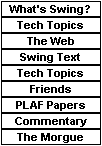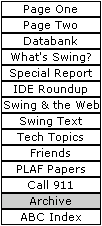 |
||||||
 |
||||||
|
|
||||||
 |
||||||
|
||||
| Archived
April 1988
Sun Ships Swing 1.0 By Mark Andrews Jon Kannegaard, vice president of software products at JavaSoft business unit of Sun Microsystems, Inc., announced the release of JFC 1.1. He said: "The JavaTM Foundation Classes usher in a new era in Java software development -- one where developers can easily create powerful, flexible applications written entirely in Java with a variety of user interface options." "The JFC software is a product of intense collaboration by developers and companies from every corner of the industry," Kannegaard continued. "We have been thrilled to see countless developers adopt the Java Foundation Classes as the basis for their Java application development." Up to now, Kannegaard noted, JFC 1.1 has been available only in the form of early-access releases that could be downloaded from the Java Developer Connection. Sessions focusing on JFC 1.1 and Swing 1.0 will be one of the highlights of the 1998 JavaOne developers' conference scheduled for March 24 through March 26 at the Moscone Convention Center in San Francisco. For more news about JavaOne -- the largest single-location developers' conference in the computer industry -- see the archived article titled "On the Swing Track at JavaOne."
Swing, AWT, and the Accessibility API Swing is an informal name for a set of Java GUI classes that extend the power and versatility of the Abstract Windowing Toolkit (AWT), an older set of GUI tools that's familiar to developers who work in the JavaTM programming language. (To find out how Swing got its name, see the box in the "Introducing Swing" article. If you're not quite sure what Swing is, read the whole article.) Swing does not replace the AWT toolkit, but exends it by adding many new classes and a host of new features. For example, Swing components have a pluggable look-and-feel (PL&F) architecture (see "Introducing Swing") that gives developers two important new benefits:
Along with Swing, JFC 1.1 includes an Accessibility API that provides support for people with disabilities. The Accessiblity API provides assistive technologies such as screen readers, screen magnifiers, and speech recognition. Development of this API followed an open-design process that based on input from experts in the assistive-technologies field.
What's new and what's ahead Even though JFC 1.1 (Swing 1.0) brings a host of benefits to developers, that's just the beginning. There's more ahead in JDK 1.2, including:
The Swing Connection will be publishing major articles about both of these APIs in upcoming issues. |
 This
issue of The Swing Connection celebrates the official release
of JFC 1.1, informally known as Swing 1.0.
This
issue of The Swing Connection celebrates the official release
of JFC 1.1, informally known as Swing 1.0.